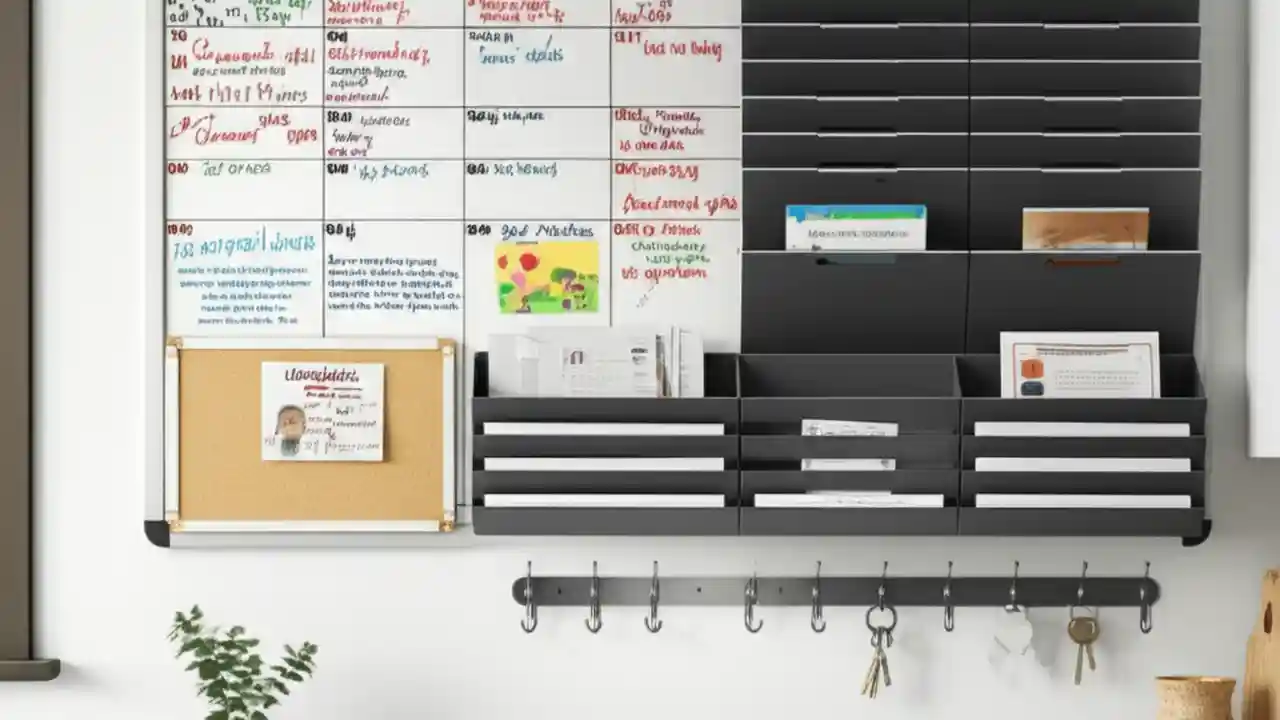The secret to an effective to-do list is simple: keep it short, scannable, and focused on action. A list that truly works isn’t a brain dump of every possible task; it’s a curated set of priorities for today. Many people struggle with their lists because they become overwhelming catalogs of “shoulds” rather than a clear plan for “wills.” This guide will transform how you approach your daily tasks.
We’ll move beyond just writing things down. We’ll explore powerful methods like the Ivy Lee and Eisenhower Matrix, break down how to craft tasks you’ll actually start, and tackle the classic digital vs. paper debate. By the end, you’ll understand how to create a to-do list that reduces stress and dramatically boosts your productivity, not one that just adds to your anxiety.
Table of Contents
The Anatomy of a Perfect To-Do List: Core Principles
Before diving into fancy methods or apps, let’s get the fundamentals right. The structure and language of your list are more important than the medium you use. Getting these basics down is the first step toward a list that serves you, not the other way around.
How many items should be on a daily to-do list?
For most people, the magic number is between 3 and 5 important tasks per day. This might sound surprisingly low, but it’s rooted in realism. We all have a limited amount of peak energy and focus. A shorter list forces you to prioritize what truly matters.
I used to create “marathon lists” with 20+ items. I’d end the day feeling defeated, having only crossed off a few. The shift to a “1-3-5” rule was a game-changer for me: identify 1 major task, 3 medium tasks, and 5 small tasks you want to accomplish. This provides structure and a sense of achievement as you check things off.
- Major Task (The “Big Rock”): The one thing that, if completed, would make your day a success.
- Medium Tasks: Important duties that require significant effort but less than the major task.
- Small Tasks: Quick items like responding to a specific email or making a phone call.
Should I use verbs? How should I phrase my tasks?
Absolutely. Always start each item with an action verb. This is a small psychological trick that shifts your mindset from passive to active. A vague task like “Mom’s birthday” is a dead end. What about it? It creates mental friction because you still have to decide what to do.
Instead, be specific and start with a verb. Here’s a quick comparison:
| Vague Task (Avoid) | Actionable Task (Use) |
|---|---|
| Website project | Draft the “About Us” page for the new website |
| Taxes | Gather all 2024 receipts for the accountant |
| Doctor’s appointment | Call Dr. Smith’s office to schedule my annual check-up |
This clarity removes the guesswork. You know exactly what “done” looks like, making it much easier to start.
What’s the difference between a to-do list and a brain dump?
This is a crucial distinction. A brain dump is the raw material; a to-do list is the finished product. You should have both, but they must be separate.
A brain dump (or a “master list”) is where you capture everything—every idea, reminder, and potential task that pops into your head. It’s messy, unfiltered, and long. It’s for getting things out of your head so you don’t forget them.
A to-do list is a curated, prioritized selection of tasks pulled from your brain dump that you intend to accomplish in a specific timeframe (usually a day or a week). Think of it this way: Your brain dump is the grocery store; your daily to-do list is the recipe you’re cooking today.
Popular To-Do List Methods: Finding Your System
There’s no single “best” method; the right one depends on your personality and the nature of your work. The key is to experiment and find a system that clicks for you. Let’s explore a few of the most effective and time-tested techniques.
What is the Ivy Lee Method?
The Ivy Lee Method is a century-old productivity hack that is brilliant in its simplicity. It’s perfect for people who feel scattered and need to build focus.
Here’s how it works, step-by-step:
- At the end of each workday, write down the six most important things you need to accomplish tomorrow. Just six.
- Prioritize those six items in order of their true importance.
- When you arrive the next day, concentrate only on the first task. Work until the first task is finished before moving on to the next one.
- Work your way down the rest of your list in the same fashion.
- At the end of the day, move any unfinished items to a new list of six for the following day.
The power of this method is its insistence on single-tasking and pre-planning. You eliminate decision fatigue in the morning because you already know exactly where to start.
How can I use the Eisenhower Matrix for my tasks?
The Eisenhower Matrix is a decision-making tool that helps you prioritize tasks based on urgency and importance. It’s ideal for people who are busy but not necessarily productive, helping you focus on what’s truly valuable, not just what’s loud.
You draw a four-quadrant box and sort your tasks:
- Quadrant 1: Urgent and Important (Do): Crises, deadlines, pressing problems. Handle these immediately.
- Quadrant 2: Not Urgent but Important (Decide/Schedule): Strategy, planning, relationship building, new opportunities. This is where you should spend most of your time for long-term success. Schedule these tasks.
- Quadrant 3: Urgent but Not Important (Delegate): Some meetings, many interruptions, other people’s minor issues. Delegate these if possible or minimize them.
- Quadrant 4: Not Urgent and Not Important (Delete): Time-wasters, trivial tasks, some emails. Eliminate these ruthlessly.
Consistently using this matrix trains you to see the difference between being “busy” (Quadrant 3) and being “effective” (Quadrant 2).
What about Time Blocking or Task Batching?
These are excellent techniques to use in conjunction with your to-do list. They are about *how* and *when* you do your tasks.
Time Blocking: Instead of just listing what you need to do, you assign a specific block of time on your calendar to do it. For example, instead of a task “Write blog post,” you block out 9:00 AM – 11:00 AM on your calendar for “Writing: First draft of productivity blog post.” This treats your tasks with the same respect as appointments.
Task Batching: This involves grouping similar small tasks together and doing them all in one go. For instance, instead of answering emails as they arrive, you set aside two 30-minute blocks per day to process all your emails at once. This is incredibly efficient because it minimizes context switching, where your brain has to constantly re-adjust to different types of work.
Common To-Do List Mistakes (And How to Fix Them)
If you’ve tried to-do lists before and failed, it’s likely not your fault. You probably fell into one of these common traps. Recognizing them is the first step to creating a system that sticks.
Why does my to-do list make me feel overwhelmed?
This is the most common complaint, and it usually stems from two issues: the list is too long, or the tasks are too big.
- The Fix for “Too Long”: Be ruthless about prioritizing. Use the Ivy Lee (only 6 items) or the 1-3-5 method. Your daily list is not a “someday/maybe” list. It’s a commitment for the next 24 hours.
- The Fix for “Too Big”: You’re listing projects, not tasks. “Renovate Kitchen” is a project. It’s terrifying and has no clear starting point. Break it down into the very first, smallest possible action. For example: “Measure kitchen dimensions” or “Browse Pinterest for cabinet ideas for 20 minutes.” A task you can complete in one session (typically under 90 minutes) is a good target.
What if I never finish my list?
First, it’s okay. The purpose of a to-do list isn’t to achieve a 100% completion rate every single day. Its purpose is to ensure you’re always working on the most important thing at any given moment. Life happens—interruptions, emergencies, tasks taking longer than expected.
The solution is a daily review. At the end of the day, look at what’s left. Ask yourself: Is this still important? If yes, consciously move it to tomorrow’s list. If no, delete it. This intentional review process prevents your list from becoming a graveyard of failed tasks and gives you a fresh, realistic start each morning.
Should I put appointments or routine habits on my list?
This is a matter of personal preference, but here’s a good rule of thumb: If it has a set time, it belongs on your calendar, not your to-do list. Your calendar manages your time; your to-do list manages your tasks. Putting “10:00 AM Dentist Appointment” on your to-do list just adds clutter.
For routine habits like “Go for a run” or “Meditate,” consider using a separate habit tracker. This keeps your to-do list focused on specific, often one-off tasks for the day, preventing it from becoming a checklist of your entire daily routine.
Digital vs. Analog: Choosing Your Weapon
The debate between digital apps and a simple notebook is endless. Neither is inherently better; they just serve different needs and personalities. I’ve used both extensively and found that the best system is the one you’ll consistently use.
What are the pros and cons of digital to-do list apps?
Digital tools (like Todoist, Trello, or Asana) are powerful and flexible. They are great for people who manage complex projects or collaborate with teams.
| Pros of Digital Lists | Cons of Digital Lists |
|---|---|
| Accessible anywhere (phone, computer) | Can be complex and distracting (fiddling with settings) |
| Easy to set recurring tasks and reminders | The “out of sight, out of mind” problem |
| Integration with calendars and other apps | Potential for notifications to become another interruption |
| Great for collaboration and sharing lists | Less satisfying to “check off” an item digitally |
When is a paper to-do list better?
Never underestimate the power of pen and paper. A simple notebook or a pad of paper can be incredibly effective, especially for your daily to-do list.
Paper is better when:
- You get easily distracted. A notebook doesn’t have notifications or the temptation of social media. It has one job.
- You want to be more intentional. The physical act of writing something down forces you to slow down and consider the task more carefully.
- You love the satisfaction. Physically striking through a completed task with a pen provides a powerful sense of accomplishment that a digital checkmark can’t always replicate.
A hybrid approach is often best: use a digital tool like Trello for your long-term project planning (the “brain dump”) and a simple paper notebook for your focused, top 3-5 priorities for the day.
Making It a Habit: How to Stick With Your To-Do List
Creating the list is only half the battle. The real magic happens when you build a consistent habit of using it. This requires a simple routine and a bit of self-compassion.
How do I make planning a consistent habit?
Link it to an existing habit. This is called “habit stacking.” Do you have a coffee every morning? Your new habit is: “After I start the coffee maker, I will review my to-do list for the day.”
The best time to plan is either the night before or first thing in the morning. I’m a firm believer in the “night before” approach (like with the Ivy Lee Method). It closes out the current day and lets you start the next day with momentum, not indecision. Spend just 5-10 minutes reviewing your master list and calendar to choose your priorities for tomorrow.
What should I do when I fall off the wagon?
First, forgive yourself. It happens to everyone. The goal is not perfection; it’s progress. Don’t let one or two missed days derail your entire system.
Second, diagnose the problem. Why did you stop? Was your list too long? Were your tasks too vague? Was the system too complicated? Often, the reason we abandon a system is that it’s not working for us. Instead of forcing it, adjust it. Simplify. Go back to basics: just write down the three most important things for tomorrow on a sticky note. That’s it. You can rebuild the habit from there.
Conclusion
An effective to-do list is not a chain that ties you to your desk; it’s a key that unlocks focus and clarity. Remember the core principles: keep it short, use action verbs, and break big projects into small, manageable steps. Experiment with methods like Ivy Lee or the Eisenhower Matrix to find what fits your workflow.
Whether you choose a digital app or a simple notebook, the goal is the same: to create a tool that serves your productivity, reduces your stress, and helps you end each day with a sense of accomplishment. Now, go create a list for tomorrow that you can actually conquer. If this guide helped you, consider sharing it with a friend who’s drowning in their tasks!







